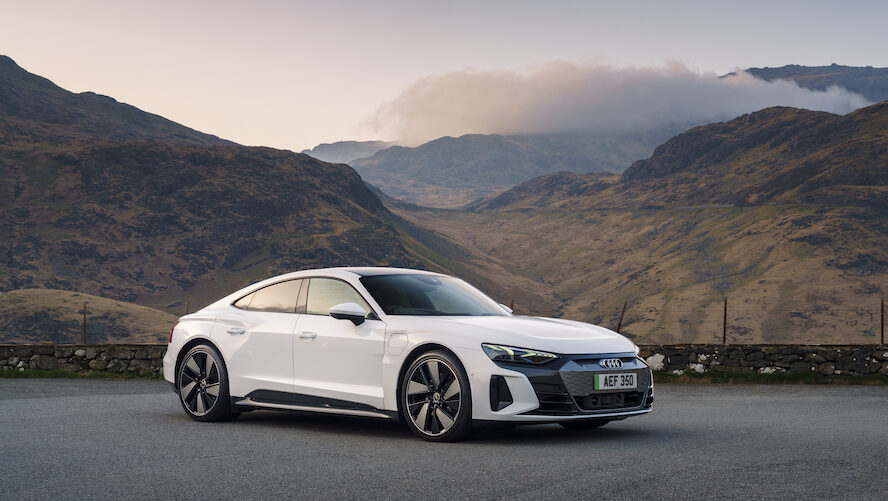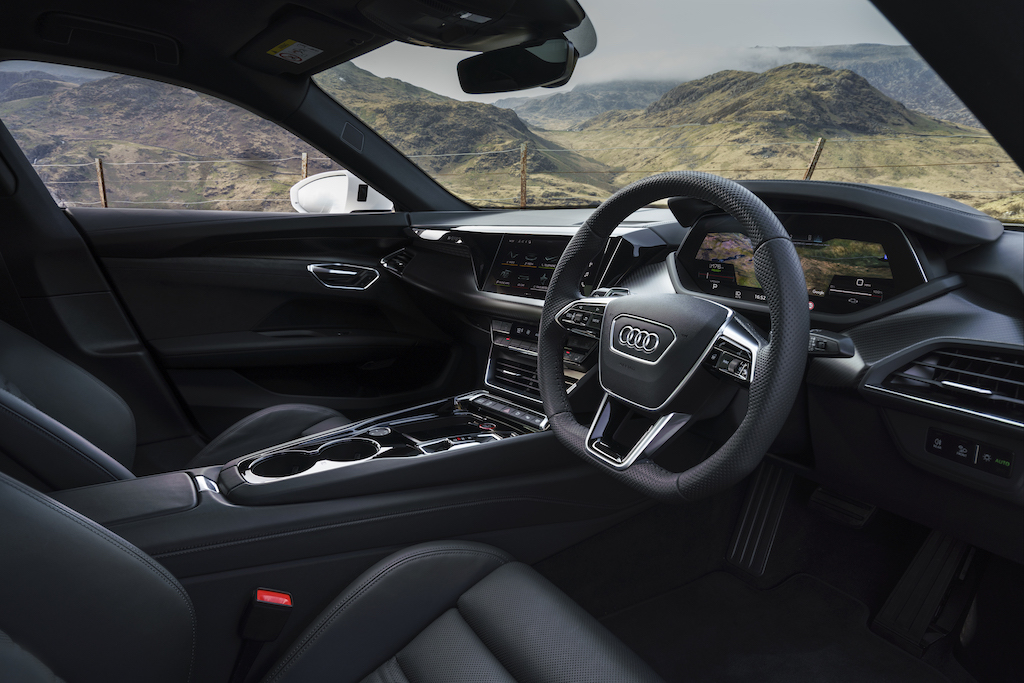Audi’s powerful all-electric e-tron vehicle range offers everything from vegan leather interiors to holographic displays. But is the world ready to support the revolution? Olivia Palamountain takes it for a test-drive around Scotland.
I’ve had a soft spot for Audi ever since my first love sped me around Europe in his Ascari blue A3 (swoon). But as my co-pilots have “evolved” over the years, so has the brand.
Today, Audi is at the forefront of the electric vehicle (EV) revolution: its first all-electric sports cars, the e-tron GT and RS e-tron GT (plus an SUV, the Q4 e-tron) launched this spring to critical acclaim, with four and five-star reviews across the board.
But while the experts are impressed with the latest EVs, is anyone actually buying them? According to the latest forecast by investment bank UBS, by 2025 20 per cent of all new cars sold globally will be electric. That figure will leap to 40 per cent by 2030; by 2040 virtually every new car sold globally will be electric. Optimistic as those figures sound, UBS can’t be far off, because even the most determined petrolhead will have to turn sparky.
Optimistic as those figures sound, UBS can’t be far off, because even the most determined petrolhead will have to turn sparky.
Why? As Neil Winton writes in Forbes: “The bottom line here though is really a one-way bet. Electric cars are bound to succeed sooner or later because governments will make it impossible for consumers to buy traditional ones.”
The edicts are in already: Norway will ban the sale of all fossil fuel-based cars by 2025; the UK will follow suit by 2030, with hybrids added to the list 2035.
Some countries are offering financial incentives to support the sales of EVs – Germany currently sweetens the deal with a subsidy of around £8,000. With the Audi e-tron range costing from £79,000 for a very basic model, it’s probably worth relocating to Germany if you feel like investing.
So, quite apart from zero emissions, what makes these new GT sports cars so special? Ultra-rapid, low and wide, these mean machines do sexy very well indeed, only this time, served with a serious side of sustainability.
I tend to skip straight to how cars make me feel rather than regurgitate the geeky details, but in this instance, the small print is both important and interesting. But we’ll keep it softcore, promise. Yes, the e-tron range encompasses instantly accessible accelerative force and incisive handling, plus exceptional cruising comfort and sophisticated infotainment – but it also comes in an optional leather-free design package. Stella McCartney eat your (vegan) heart out!
Yes, the e-tron range encompasses instantly accessible accelerative force and incisive handling, plus exceptional cruising comfort and sophisticated infotainment – but it also comes in an optional leather-free design package. Stella McCartney eat your (vegan) heart out!

The model I drove was the e-tron GT, which features upholstery in a combination of artificial leather and Cascade, a new material which is produced using a proportion of recycled materials such as polyester fibres made from old plastic bottles, textiles, or residual fibres from selvages.
Dinamica, a microfibre material that comprises recycled fibres is also incorporated into the design, throughout the centre console and the upper sections of the door inserts, plus in the upper part of the instrument cluster.
In both the Nappa leather and vegan leather options, the floor carpets and floor mats are made from Econyl, a neat material that consists of 100-percent recycled nylon fibres from production waste, fabric and carpet remnants – or even old fishing nets.
The smell of supple leather in a car is nostalgic for lots of people, however, I’m pleased to report that the vegan version is just as alluring. It’s not just the smell inside the e-tron that has me excited, the look and feel of this beast also packs a punch.
Both futuristic and luxurious, I feel the absolute dog’s bollocks cocooned in Audi’s brave new world. High-tech features such as the massive infotainment screen and customisable digital dashboard sit alongside heritage touches that are unmistakably Audi and lend some gravitas to the experience. Powering up the e-tron GT is at once familiar and novel. Instead of the throaty roar I associate with most supercars – that one that announces to the world that you mean business – the e-trons keyless go engages like a silent ninja.
Powering up the e-tron GT is at once familiar and novel. Instead of the throaty roar I associate with most supercars – that one that announces to the world that you mean business – the e-trons keyless go engages like a silent ninja.
There’s very little sound at all, and the surreal whirring, purring sound that is audible is completely synthetic, digital signatures composed by Audi engineers Rudolf Halbmeir and Stephan Gsell. Electric cars need sound, both to signal their presence to pedestrians and to provide a feeling of familiarity to drivers: how the voice of the e-tron GT was brought to life is extraordinary.
“In principle, the sound of a car has much in common with music,” says Rudolf Halbmeir. The Audi sound designer is a dedicated musician who writes songs in his spare time and plays all the instruments himself in his private recording studio.
“To find the basis for the sound of the e-tron GT, I tried all sorts of instruments, from the violin to the electric guitar all the way to the didgeridoo. But none of them were really suitable.
“Then I came across a piece of plastic pipe lying in the garden, it was three meters long and had a cross-section of 80 millimeters. I attached a fan at one end and listened to the sound coming out the other end. It was a very specific, deep growl – and I knew straight away that I had discovered the foundation of the sound.”
This was then developed into a sample of 32 sounds including a processed synthesiser, the noise made by a cordless screwdriver and recordings of a model helicopter. On the endless Scottish road, this car just keeps on delivering. Two whopping electric motors power the Audi e-tron GT: the acceleration is mad (in a good way) and you can fly from 40 mph to 100 mph as fast and efficiently as a bullet. Everything about this ride is silky smooth, and with none of the petrol engine acceleration drag, it’s it’s easy to drive much faster than intended.
On the endless Scottish road, this car just keeps on delivering. Two whopping electric motors power the Audi e-tron GT: the acceleration is mad (in a good way) and you can fly from 40 mph to 100 mph as fast and efficiently as a bullet. Everything about this ride is silky smooth, and with none of the petrol engine acceleration drag, it’s it’s easy to drive much faster than intended.
Sophisticated gadgetry is everywhere. At one stage, I’ve got all three navigation systems on simultaneously: one in the middle screen, one in the dash and a sci-fi hologram that floats at eye level in the windscreen. The latter buzzes like my head on a hangover, distracting focus from the road and making me regret my breakfast.
I’d happily keep cruising the high-voltage battery’s full 252 miles of charge, smug in the knowledge that my journey is both efficient and also completely C0₂ free. But despite this impressive range, it’s the essential charging process that presents a potential pitfall in the acceleration of the EV revolution.
At present, charging points are sporadic, come in varying degrees of efficiency and cost and are not always wall maintained. Additionally, unlike petrol stations, in the vast majority of cases you can’t just park up and charge.
Further complications are far-reaching and include brand-specific restricted network use (Tesla is leading the way), confusing charges (some charge points and networks charge per minute, rather than by kWh) and no standardised sockets.
Considering we’re supposed to be all-electric by 2035, this is worrying. But in a car this cool, I reckon we just enjoy the ride.

